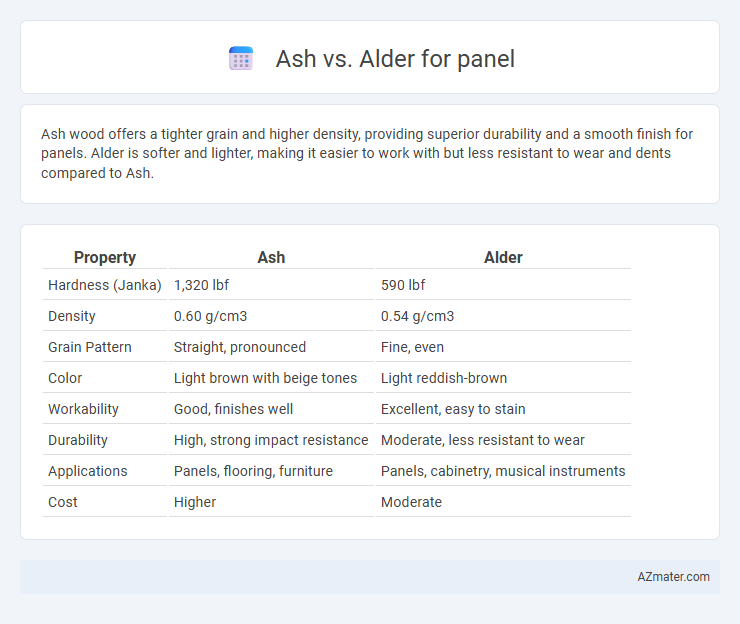Ash wood offers a tighter grain and higher density, providing superior durability and a smooth finish for panels. Alder is softer and lighter, making it easier to work with but less resistant to wear and dents compared to Ash.
Table of Comparison
| Property | Ash | Alder |
|---|---|---|
| Hardness (Janka) | 1,320 lbf | 590 lbf |
| Density | 0.60 g/cm3 | 0.54 g/cm3 |
| Grain Pattern | Straight, pronounced | Fine, even |
| Color | Light brown with beige tones | Light reddish-brown |
| Workability | Good, finishes well | Excellent, easy to stain |
| Durability | High, strong impact resistance | Moderate, less resistant to wear |
| Applications | Panels, flooring, furniture | Panels, cabinetry, musical instruments |
| Cost | Higher | Moderate |
Introduction to Ash and Alder Wood for Paneling
Ash and alder wood are popular choices for paneling due to their distinct characteristics and aesthetic appeal. Ash features a light color with a straight grain pattern, offering durability and a smooth finish ideal for both traditional and modern interiors. Alder wood provides a warm, reddish-brown tone with a fine, uniform texture, making it suitable for creating a cozy and inviting atmosphere in paneling applications.
Botanical Differences: Ash vs Alder
Ash (genus Fraxinus) trees belong to the Oleaceae family and feature compound leaves with multiple leaflets, typically opposite in arrangement, whereas Alder (genus Alnus) trees are part of the Betulaceae family and have simple, serrated leaves with alternate placement. Ash wood exhibits a straight grain and a coarse texture, contrasting with Alder's fine, uniform texture and more subtle grain patterns. Botanically, Ash produces winged samaras as fruit, while Alder generates small, woody cones, reflecting key reproductive distinctions between these two species.
Grain Patterns and Aesthetic Appeal
Ash wood features pronounced, straight grain patterns with a light tan to brown color, offering a clean and contemporary look ideal for modern panels. Alder wood exhibits a more uniform, fine grain with a warm reddish-brown hue, providing a subtle and classic aesthetic appeal. Both woods enhance interior paneling, but Ash delivers a bolder texture while Alder contributes softness and warmth to the design.
Durability and Strength Comparison
Ash offers superior durability and strength compared to alder, making it a preferred choice for high-traffic panel applications. Its dense grain structure provides excellent resistance to impact and wear, ensuring longer-lasting performance. Alder, while softer and easier to work with, lacks the hardness and resilience required for panels subjected to heavy use or environmental stress.
Workability: Tools and Techniques
Ash wood offers superior workability for panel applications due to its straight grain and consistent texture, making it easier to cut, shape, and sand with both hand and power tools. Alder, while softer and lighter, allows smooth planing and staining but may require more careful handling to avoid dents or gouges during machining. Both woods respond well to common woodworking techniques, but ash's durability and resistance to wear provide a more forgiving surface for intricate tool work.
Cost and Availability Analysis
Ash wood, known for its strength and shock resistance, typically commands a higher price due to its limited availability and slow growth rate, making it a premium choice for panels in high-end applications. Alder wood offers a cost-effective alternative with moderate durability and widespread availability, particularly in North America, resulting in lower procurement expenses for large-scale panel production. Market fluctuations and regional supply chain factors further impact the pricing dynamics of both ash and alder panels, with ash often incurring higher transportation costs.
Finishing Options for Ash and Alder Panels
Ash panels offer a wide range of finishing options including clear varnish, stain, and paint, highlighting their distinctive open grain and light color variations. Alder panels provide a smoother surface that readily accepts stains and paints, enabling uniform color application and a rich, warm finish. Both woods respond well to sealing and sanding, but Ash's textured grain pairs better with transparent finishes, whereas Alder excels under opaque coatings.
Environmental Impact and Sustainability
Ash wood offers excellent sustainability due to its rapid growth rate and widespread availability in temperate regions, making it a renewable choice for panel production. Alder, while slower-growing, has a lower environmental footprint during processing because it requires less energy to mill and finish, enhancing its eco-friendly profile. Both woods are biodegradable and can be sourced from responsibly managed forests, but Ash's faster regeneration often positions it as the more sustainable option in large-scale applications.
Practical Applications in Interior Design
Ash wood offers exceptional durability and a light, attractive grain, making it ideal for sleek, modern panels in interior design that require both strength and aesthetic appeal. Alder, with its warm reddish-brown hue and fine texture, is favored for creating cozy, rustic paneling that complements traditional or craftsman-style interiors. Both woods respond well to staining and finishing, allowing designers to tailor panel colors and textures to enhance the overall ambience of residential and commercial spaces.
Choosing the Right Wood: Ash or Alder?
Ash offers superior strength and durability, making it ideal for heavy-use panels requiring longevity and a pronounced grain pattern. Alder provides a softer, more consistent texture with a warm, light color, suitable for painted or stained panels where smoothness is prioritized. Choosing between Ash and Alder depends on the desired aesthetic, usage intensity, and finishing preferences for the panel application.

Infographic: Ash vs Alder for Panel
 azmater.com
azmater.com